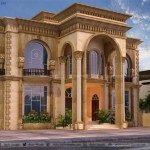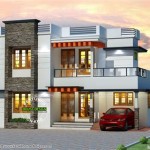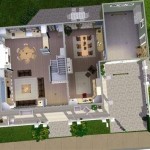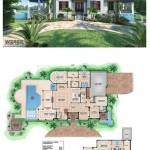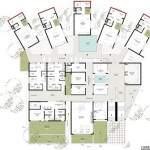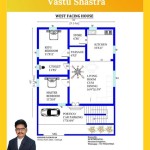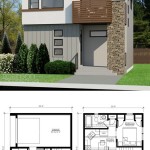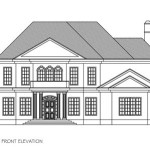Small Modern A-Frame House Plans: Efficiency and Style Combined
The A-frame house, a design characterized by its steeply angled roof forming an "A" shape, has experienced a resurgence in popularity. While traditionally associated with rustic cabins, contemporary interpretations of the A-frame design have embraced minimalist aesthetics and efficient space utilization, resulting in the rise of small modern A-frame house plans. These designs offer a unique blend of architectural interest, affordability, and sustainable living, making them an attractive option for individuals and families seeking a compact and stylish dwelling.
Small modern A-frame house plans prioritize functionality without sacrificing visual appeal. They cleverly integrate living spaces within the triangular structure, maximizing usable square footage and creating an open and airy atmosphere. This article will explore key aspects of small modern A-frame house plans, including their design principles, functional advantages, and considerations for construction.
Optimizing Space in a Triangular Footprint
The defining characteristic of an A-frame house is its steeply pitched roof, which typically forms the exterior walls. In small modern A-frame designs, this architectural feature presents both opportunities and challenges. The inherent challenge lies in the sloped walls reducing usable headroom, particularly on upper levels. However, skilled design can mitigate this issue and even turn it into an advantage.
One common strategy is to incorporate a loft area that utilizes the upper portion of the A-frame. This loft can serve as a bedroom, office, or living space, taking advantage of the naturally high ceilings at the apex of the structure. Careful planning is crucial to ensure adequate headroom and accessibility to the loft. Staircases or ladders are commonly used for access, and the placement of windows is essential to maximize natural light and ventilation.
The ground floor plan of a small modern A-frame often employs an open-concept layout. This maximizes the sense of space and allows for a seamless flow between living, dining, and kitchen areas. Strategic placement of furniture and fixtures is essential to define these zones without creating visual clutter. Built-in storage solutions, such as shelving and cabinets integrated into the walls, are particularly valuable in maximizing space and minimizing the need for bulky furniture.
Furthermore, the orientation of the A-frame on the site can significantly impact its spatial efficiency. Positioning the house to take advantage of natural light and views can enhance the feeling of spaciousness and connect the interior with the surrounding environment. Large windows and sliding glass doors are frequently incorporated into the design to maximize natural light and create a sense of connection to the outdoors.
The utilization of vertical space is another key consideration. High ceilings in the main living area can accommodate taller furniture pieces, such as bookshelves or artwork, drawing the eye upward and creating a sense of grandeur. Mezzanines can also be added to create additional living or storage space, further optimizing the use of the available area.
Material Selection and Sustainable Design
Material selection plays a crucial role in the aesthetics, durability, and environmental impact of a small modern A-frame house. Modern A-frame designs often incorporate sustainable and locally sourced materials to minimize their carbon footprint and promote environmentally responsible construction.
Wood is a common and versatile material used in A-frame construction. It can be used for the structural frame, exterior siding, and interior finishes. Engineered wood products, such as plywood and laminated veneer lumber (LVL), offer enhanced strength and stability compared to traditional lumber and can be used to create large spans and open spaces. Utilizing wood from sustainably managed forests is crucial for minimizing the environmental impact of construction.
Metal is another popular material choice, particularly for roofing and exterior accents. Metal roofing offers excellent durability and weather resistance, making it a long-lasting and low-maintenance option. Metal siding can also be used to create a sleek and modern aesthetic. Recycled metal is a sustainable alternative that reduces the demand for virgin materials.
Insulation is a critical component of any energy-efficient building, and A-frame houses are no exception. Proper insulation helps to maintain a comfortable indoor temperature and reduces energy consumption for heating and cooling. Spray foam insulation is a popular option for A-frames, as it can effectively fill gaps and crevices in the sloped walls. Other insulation options include fiberglass batts, cellulose insulation, and mineral wool.
Windows and doors should be chosen for their energy efficiency and durability. Double-paned or triple-paned windows with low-E coatings can significantly reduce heat loss in the winter and heat gain in the summer. Weatherstripping and sealing around windows and doors can further prevent air leaks and improve energy efficiency.
Finally, considering the overall environmental impact of material choices is essential. Using materials with low embodied energy and minimal off-gassing can contribute to a healthier and more sustainable living environment. Selecting locally sourced materials can reduce transportation costs and support local economies.
Addressing Practical Considerations for A-Frame Living
While small modern A-frame house plans offer numerous advantages, there are also practical considerations that need to be addressed during the design and construction process. These considerations relate to the unique features of the A-frame structure and its impact on daily living.
One of the primary challenges of A-frame living is the sloped walls, which can limit storage options and make it difficult to place certain types of furniture. Custom-built storage solutions, such as shelving and cabinets designed to fit the angled walls, are often necessary. Choosing furniture with a low profile can also help to maximize space and prevent the room from feeling cramped.
Another consideration is snow load. In areas with heavy snowfall, the steeply pitched roof of an A-frame can accumulate a significant amount of snow. It is essential to ensure that the roof structure is designed to withstand the anticipated snow load. Regular snow removal may also be necessary to prevent structural damage or ice dams.
Ventilation is crucial in A-frame houses to prevent moisture buildup and ensure good indoor air quality. Proper ventilation can be achieved through a combination of natural ventilation, such as operable windows and skylights, and mechanical ventilation, such as exhaust fans and heat recovery ventilators (HRVs). Adequate ventilation is particularly important in bathrooms and kitchens, where moisture levels tend to be high.
Accessibility can also be a concern, especially for individuals with mobility limitations. Steep staircases or ladders are often used to access loft areas, which may not be suitable for everyone. Incorporating a ground-floor bedroom and bathroom can improve accessibility for individuals with mobility issues. Ramps can also be used to provide access to the entrance of the house.
Finally, consider the acoustics of the A-frame structure. The sloped walls can create echoes and reverberations, which can be particularly noticeable in open-concept living spaces. Soft furnishings, such as rugs, curtains, and upholstered furniture, can help to absorb sound and improve the acoustics of the room. Soundproofing materials can also be incorporated into the walls and ceilings to further reduce noise transmission.
In summation, small modern A-frame house plans offer a unique and compelling design solution for individuals seeking a compact, stylish, and sustainable dwelling. By carefully considering the challenges and opportunities presented by the A-frame structure, it is possible to create a functional and aesthetically pleasing living space that embraces the principles of modern design and sustainable living.

Classic Design For A Low Budget Frame Project Small House Plans Floor

A Frame Cottage Plans For Guest House Temp Cabin Plan

Unique Small House Plans A Frames Cabins Sheds Plan With Loft

A Frame House Plans Everything You Need To Know Field Mag

Interesting A Frame Cabin House Design Idea Dream Tiny Living

Modern A Frame House Floor Plans

Amazing A Frame House Plans Houseplans Blog Com

6 Dreamy A Frame Tiny House Plans For Cute And Functional Getaway

Amazing A Frame House Plans Houseplans Blog Com

Modern A Frame Cabin House Plans Small Home 45x25 Tiny

